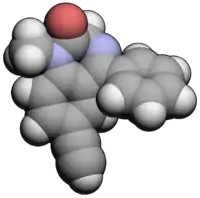QH-II-66
QH-II-66[1] (QH-ii-066) is a sedative drug which is a benzodiazepine derivative.[2] It produces some of the same effects as other benzodiazepines, but is much more selective than most other drugs of this class and so produces somewhat less sedation and ataxia than other related drugs such as diazepam and triazolam, although it still retains anticonvulsant effects.[3]
 | |
 | |
| Legal status | |
|---|---|
| Legal status |
|
| Identifiers | |
IUPAC name
| |
| CAS Number | |
| PubChem CID | |
| ChemSpider | |
| UNII | |
| ChEMBL | |
| CompTox Dashboard (EPA) | |
| Chemical and physical data | |
| Formula | C18H14N2O |
| Molar mass | 274.33 g·mol−1 |
| 3D model (JSmol) | |
SMILES
| |
InChI
| |
| | |
QH-ii-066 is a highly subtype-selective GABAA agonist which was designed to bind selectively to the α5 subtype of GABAA receptors.[4]
The α5 subtype (and to a lesser extent the α1 subtype) of GABAA are two of the most important targets in the brain that produce the effects of alcohol,[5] and so one of the purposes for which QH-ii-066 was developed was to reproduce the GABAergic effects of alcohol separately from its other actions.[6]
QH-ii-066 replicates some of the effects of alcohol, such as sedation and ataxia, but does not increase appetite, as this effect seems to be produced by the α1 subtype of GABAA rather than α5.[7] The inverse agonist Ro15-4513, which blocks the α5 subtype of GABAA, reverses the effects of alcohol, suggesting that this subtype is also important in producing the subjective effects of alcohol intoxication.[8]
See also
References
- US 2010004226, Cook JM, Hao H, Huang S, Sarma PV, Zhang C, "Stereospecific anxiolytic and anticonvulsant agents with reduced muscle-relaxant, sedative-hypnotic and ataxic effects", published 7 January 2010
- Huang Q, He X, Ma C, Liu R, Yu S, Dayer CA, et al. (January 2000). "Pharmacophore/receptor models for GABAA/BzR subtypes (α1β3γ2, α5β3γ2, and α6β3γ2) via a comprehensive ligand-mapping approach". Journal of Medicinal Chemistry. 43 (1): 71–95. doi:10.1021/jm990341r. PMID 10633039.
- US 7119196, Cook JM, Huang Q, He X, Li X, Yu J, Han D, Lelas S, McElroy JF, "Anxiolytic agents with reduced sedative and ataxic effects", issued 10 September 2006, assigned to WiSys Technology Foundation Inc
- Huang Q, Zhang W, Liu R, McKernan RM, Cook JM (1996). "Benzo-fused benzodiazepines employed as topological probes for the study of benzodiazepine receptor subtypes". Medicinal Chemistry Research. 6 (3): 384–391.
- Platt DM, Duggan A, Spealman RD, Cook JM, Li X, Yin W, Rowlett JK (May 2005). "Contribution of alpha 1GABAA and alpha 5GABAA receptor subtypes to the discriminative stimulus effects of ethanol in squirrel monkeys". The Journal of Pharmacology and Experimental Therapeutics. 313 (2): 658–67. doi:10.1124/jpet.104.080275. PMID 15650112. S2CID 97681615.
- Hodge CW, Grant KA, Becker HC, Besheer J, Crissman AM, Platt DM, et al. (February 2006). "Understanding how the brain perceives alcohol: neurobiological basis of ethanol discrimination". Alcoholism: Clinical and Experimental Research. 30 (2): 203–13. doi:10.1111/j.1530-0277.2006.00024.x. PMID 16441269.
- Duke AN, Platt DM, Cook JM, Huang S, Yin W, Mattingly BA, Rowlett JK (August 2006). "Enhanced sucrose pellet consumption induced by benzodiazepine-type drugs in squirrel monkeys: role of GABAA receptor subtypes". Psychopharmacology. 187 (3): 321–30. doi:10.1007/s00213-006-0431-2. PMID 16783540. S2CID 32950492.
- Wallner M, Hanchar HJ, Olsen RW (May 2006). "Low-dose alcohol actions on alpha4beta3delta GABAA receptors are reversed by the behavioral alcohol antagonist Ro15-4513". Proceedings of the National Academy of Sciences of the United States of America. 103 (22): 8540–5. Bibcode:2006PNAS..103.8540W. doi:10.1073/pnas.0600194103. PMC 1482527. PMID 16698930.